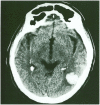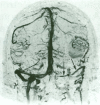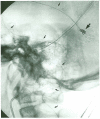Endovascular Retrograde Cortical Venous Approach to Disconnect Retrograde Leptomeningeal Venous Reflux in a Patient with Dural AVF
- PMID: 20670511
- PMCID: PMC4268687
- DOI: 10.1177/159101999900500214
Endovascular Retrograde Cortical Venous Approach to Disconnect Retrograde Leptomeningeal Venous Reflux in a Patient with Dural AVF
Abstract
We report a case of dural arteriovenous fistual (DAVF) with cortical venous reflux in whom disconnection of the refluxing cortical vein was achieved by using a retrograde transcortical venous approach through the cortical vein itself.
Figures






Similar articles
-
[Evolution of angiographic signs of venous hypertension and clinical signs of intracranial hypertension in intracranial dural arteriovenous fistulas].J Neuroradiol. 1999 Mar;26(1):49-58. J Neuroradiol. 1999. PMID: 10363442 French.
-
Endovascular treatment of sphenoid wing dural arteriovenous fistula with pure cortical venous drainage.J Stroke Cerebrovasc Dis. 2014 Jul;23(6):1730-5. doi: 10.1016/j.jstrokecerebrovasdis.2013.12.037. Epub 2014 Feb 28. J Stroke Cerebrovasc Dis. 2014. PMID: 24582791
-
Selective disconnection of cortical venous reflux as treatment for cranial dural arteriovenous fistulas.J Neurosurg. 2004 Jul;101(1):31-5. doi: 10.3171/jns.2004.101.1.0031. J Neurosurg. 2004. PMID: 15255248
-
Updates in the management of cranial dural arteriovenous fistula.Stroke Vasc Neurol. 2019 Nov 21;5(1):50-58. doi: 10.1136/svn-2019-000269. eCollection 2020. Stroke Vasc Neurol. 2019. PMID: 32411408 Free PMC article. Review.
-
Long-term outcome after endovascular treatment of cavernous sinus dural arteriovenous fistula and a literature review.Acta Neurochir (Wien). 2017 Nov;159(11):2113-2122. doi: 10.1007/s00701-017-3336-4. Epub 2017 Sep 20. Acta Neurochir (Wien). 2017. PMID: 28932918 Review.
References
-
- Davies MA, Saleh J, et al. The natural history and management of intracranial dural arteriovenous fistulae: benign lesions. Interventional Neuroradiology. 1997;3:295–302. - PubMed
-
- Davies MA, terBrugge K, et al. The natural history and management of intracranial dural arteriovenous fistulae: aggressive lesions. Interventional Neuroradiology. 1997;3:303–311. - PubMed
-
- Borden JA, Wu KW, Shucart WA. A proposed classification for spinal and cranial dural arteriovenous fistulous malformations and implications for treatment. J Neurosurg. 1995;82:166–179. - PubMed
-
- Cognard C, Gobin YP, et al. Cerebral dural arteriovenous fistulas: clinical and angiographic correlation with a revised classification of venous drainage. Radiology. 1995;194:671–680. - PubMed
-
- Morris YS, Willinsky R, et al. Abstract, Annual meeting, Joint meeting of Section of Cerebrovascular Surgery and the American society of Interventional and Therapeutic Neuroradiology held at Nashville. TN: 1999. Outcome following surgical treatment of 47 aggressive (Borden type II and III) cranial dural arteriovenous fistulae; p. 73.
LinkOut - more resources
Full Text Sources

